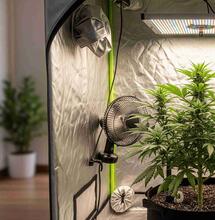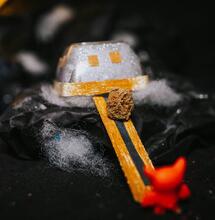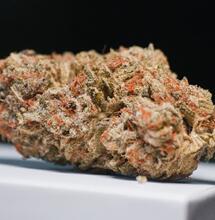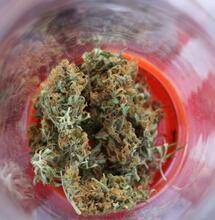What Should You Know About Foliar Nutrition?
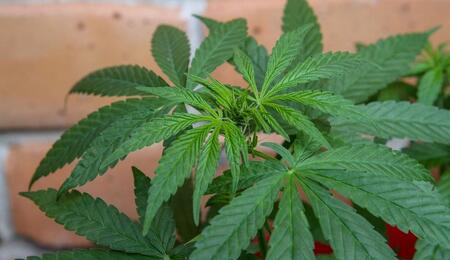
Foliar feeding involves spraying your cannabis plants with nutrient solutions and it can aid them when they appear malnourished. That is just one of many benefits, however. The main rule with foliar feeds is to proceed only when the plants are in the vegetative stage. You can also foliar feed weed plants in the beginning of flowering, but must stop as soon as flowers form.
Foliar feeds can save the day when your plants are deficient in nutrients, and some of them can even help deter pests. In this article, we explain everything you need to know about foliar nutrition of your cannabis plants, and what kind of feeds to use depending on the situation in the grow room.
10 Things You Should Know About Foliar Feeds
It looks like a simple way to nourish your cannabis plants, but there are things every grower should be aware of in order to avoid making mistakes with foliar nutrients.
1. Foliar Feeding Can Contaminate Flowers
This is the main reason why you want to apply foliar nutrients on your cannabis plants only during vegetation, and possibly in the early days of the flowering period. If you continue spraying the plants once the flowers appear, it might change the taste and smell of the harvest in a funky way, which is something you definitely want to avoid.
2. Only Do Foliar Nutrition When the Lights Are Off
Darkness allows for a better absorption of nutrients. It has to do with the stomata, the little pores on the leaves that are engaged in key chemical processes.
The stomata in cannabis plants are opened for only a short period of time, typically in the early evening, therefore the ideal window of time to apply foliar feeds on your cannabis plants is early evening, or once you switch off the lights in the grow room.
You should avoid feeding when the lights are still working, because the nutrient droplets can amplify the light and this might cause leaf burns, plus the power of lights will also degrade the nutrient compounds. If you are growing outdoors, wait after sunset to spray the plants.
3. Spray All Over the Leaves
In foliar feeding, it’s important to spray the entire plant. Not only the visible parts of the canopy or the upper sides of the leaves, but also their under sides. The back side is actually the faster route for nutrient absorption, as there are more stomata pores on that part.
If you are using foliar nutrients to deter pests, the only way to do it correctly is to apply the solution on the most obvious hiding spots. Which is, again, underneath the leaves. Mites and aphids are more likely to nest there.
4. Test Spray a Small Number of Leaves
Before you bathe the entire plant with foliar nutrients, it’s good that you first test with a small number of leaves and observe what happens for a day. If everything looks alright, expand the operation and spray the entire plant in the next feeding session.
5. Don’t Feed When the Temperatures Are Too High or Low
The optimal temperature range for weed plants in their vegetative stage of growth is somewhere between 68 and 77 degrees Fahrenheit. Using foliar nutrients outside this range can lead to problems.
The stomata pores can completely close when the temperature in the grow room rises above the recommended range. The same happens with outdoor plants in the afternoon when temperatures usually reach their peak. Applying foliar sprays in these instances would be way less effective.
Problems can also occur if the temperatures are too low. The evaporation of water will go slow, the uptake of nutrients will not go smoothly, and the biggest danger is the formation of fungal growth.
6. Sprays Can Protect Against Pests and Fungal Growth
Some cannabis strains are more vulnerable to attract pests or develop fungal infection. Excess in humidity in the growing environment can also lead to contamination. Foliar pesticides and insecticides are essential tools that can help protect your plants from various gritty bugs, spores and fungi.
7. Foliar Nutrition Can Correct Nutrient Deficiency
Spraying nutrient formulas on the foliage can reverse nutrient deficiencies when pot plants are in their vegetative stage. Most cultivars will quickly absorb the extra nutrients you administer during this period.
With nutrient deficiencies, it’s also important to check on the pH in the grow medium and perform flushing if needed. Continue with the regular feeding schedule only when you’re done dealing with the deficiency.
8. Surfactants Are Useful with Foliar Spray
Surfactants or wetters can ensure a better distribution of the liquid nutrient solution on the entire cannabis plant. Adding insecticidal soap will increase the spray’s retention, and it will also eliminate all kinds of bugs such as aphids, whiteflies and spider mites.
9. Foliar Feeds Can Also Cause Overfeeding
You might think that there are less chances to overfeeding your cannabis plants with foliar nutrients, especially when addressing a deficiency problem, but that’s not exactly the case.
With foliar nutrients, it’s important to dilute the solution and only use about 30% of the feeding that you would normally use for the root drench. Overdoing it could present with symptoms of nutrient burns on the leaves. There’s no need to use a more concentrated spray solution. Only spray once, in the early evening.
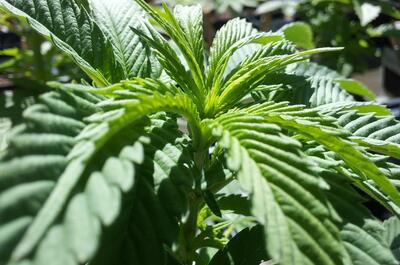
10. Not All Foliar Sprays Are Made Equal
Lastly, you have to tell your foliar nutrient boosters from your foliar pesticides and antifungals. Using the right spray for your operation or the problem you’re trying to correct is crucial.
Suppose you have a small grow room with a couple of plants to handle. In that case, a hand sprayer will do. For a larger number of crops, consider using a pump sprayer.
Below, check some of the most common types of foliar nutrients and sprays used for growing cannabis.
Neem Oil
Neem oil is the go-to solution when you’re trying to address a fungal or pest infestation taking over your pot plants. Neem oil is 100% organic and safe to use on plants in their vegetative phase. It can eliminate fungal spread, aphids, thrips, mites, whiteflies and other similar critters. Even if the plants look healthy and clean, you can spray them with neem oil once every couple of weeks as a precaution.
Aloe Vera
Another organic solution is aloe vera. The juice from aloe vera is rich in micronutrients, enzymes and amino acids that can facilitate a nutrient deficiency problem, and even protect from any unwanted infestations. Preparing an aloe vera foliar feed is easy: combine two teaspoons of aloe vera gel with 1.2 gallons of water and mix well.
Fulvic Acid
Fulvic acid is another essential in the palette of foliar nutrients. Molecules from fulvic acid are sufficiently small and biologically very active. Fulvic acid can nourish cannabis plants with trace minerals such as copper, manganese, zink, iron, etc. It improves mineral absorption, and can boost the plant’s natural resistance to stress.
Humic Acid
Humic is a chelator, which means it supports the bonding of minerals into organic compounds that are then more easily soaked up by the plant. Humic substances can break down insoluble nutrients. Humic acids also contain fulvic acids since both are byproducts of degraded organic matter such as humus.
Reynoutria Sachalinensis
Don’t be afraid of the Latin designation. Reynoutria Sachalinensis is just another name for giant knotweed. This extract boosts the innate immune system of cannabis plants. Using knoweed solution activates the defense mechanisms of weed plants, which is crucial in fighting off fungal infections, including the common ones like powdery mildew.
Saponin Extract
Saponin is collected from hundreds of different plants. A saponin extract is packed with a host of antimicrobials, and it also makes for a great surfactant. Therefore, saponin-based surfactants are a great addition to both foliar sprays and foliar pesticides.
Harpin Protein
Harpin protein also activates the plant’s defense system. The difference with harpins is that they engage differently than most pesticides. The protein does not attack directly fungal or pest infestation. Rather, they increase the plant’s Systemic Acquired Resistance (SAR). Harpin proteins are commonly used in hydroponic growth settings.
Potassium Silicate
Potassium silicate is a major source for silicic acid, which plants utilize to store water between cells. The Earth’s crust is abundant with silica, therefore there’s no need to worry about silicic acid when growing outdoors. However, a hydroponic grow setting could certainly use a small boost in potassium. Potassium combined with neem oil is also one of the most powerful pest control solutions.
Also read on Soft Secrets:
- A Beginner’s Guide to Cannabis Nutrients
- Different Types of Natural Fertilizers for Cannabis Plants

